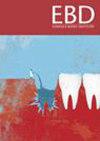Do chewing gums and sweets containing xylitol prevent caries in children?
Q3 Dentistry
引用次数: 0
Abstract
Three electronic databases (Pubmed, Embase and the Cochrane Library) were searched in December 2022, and again for additional literature on 3–5th January 2023. Reference lists of relevant systematic reviews were hand searched for other eligible studies for inclusion. Randomised controlled clinical trials and controlled clinical trials conducted on children (aged ≤ 18 years), conducted between 1974–2022 and available in English, were eligible for inclusion. Studies were excluded if caries was not an outcome, the control group was not sufficient, they were lab-based studies or studies where xylitol delivery was not a sweet or chewing gum and where the xylitol product contained a component such as fluoride which may influence the outcomes. Four calibrated reviewers independently screened titles and abstracts, and disagreements were resolved via group discussion. Preventative effect was determined by comparing the mean caries increment in the control and intervention groups, producing a preventative fraction. A total of 617 titles were initially screened for relevance. After duplicate removal, 268 abstracts were screened and 16 full text articles reviewed, with one more study then excluded. 10 studies investigated xylitol-containing chewing gum, and six looked at xylitol candy (one did both). Eight included studies were randomised controlled trials. Data extraction was undertaken by two reviewers. 3466 participants were included in the 10 studies that investigated xylitol chewing gum, and all 10 studies reported a statistically significant preventive effect compared to a no chewing gum or placebo control. In 9 studies, the preventive fraction was clinically significant. The six studies investigating xylitol candies contained a total of 1023 participants, and only one study demonstrated a significant preventative effect. There is some evidence that incorporating xylitol chewing gum daily has a caries-reducing effect in those with a moderate-to-high baseline caries level. This effect was not present for xylitol sweets.含木糖醇的口香糖和糖果能预防儿童龋齿吗?
数据来源于 2022 年 12 月检索了三个电子数据库(Pubmed、Embase 和 Cochrane 图书馆),并于 2023 年 1 月 3-5 日再次检索了其他文献。研究筛选1974-2022年期间进行的、以儿童(年龄小于18岁)为对象的随机对照临床试验和对照临床试验,可用英语进行。如果龋齿不是研究结果,对照组不够充分,研究是基于实验室的,或者研究中木糖醇不是甜食或口香糖,以及木糖醇产品中含有氟化物等可能影响研究结果的成分,则排除这些研究。通过比较对照组和干预组的平均龋齿增量,得出预防分数,从而确定预防效果。最初共筛选了 617 篇标题,以确定其相关性。去除重复内容后,筛选出 268 篇摘要,并对 16 篇全文进行了审查,随后又排除了一篇研究。10 项研究调查了含木糖醇的口香糖,6 项研究调查了木糖醇糖果(1 项研究同时调查了这两种食品)。其中八项研究为随机对照试验。结果10项调查木糖醇口香糖的研究共纳入3466名参与者,所有10项研究均报告,与不含口香糖或安慰剂的对照组相比,木糖醇口香糖具有统计学意义上的显著预防效果。在9项研究中,预防效果具有临床意义。调查木糖醇糖果的六项研究共有 1023 名参与者,只有一项研究显示了显著的预防效果。结论有证据表明,对于基线龋齿水平为中度至高度的人群,每天食用木糖醇口香糖具有减少龋齿的效果。木糖醇糖果则没有这种效果。
本文章由计算机程序翻译,如有差异,请以英文原文为准。
求助全文
约1分钟内获得全文
求助全文
来源期刊

Evidence-based dentistry
Dentistry-Dentistry (all)
CiteScore
2.50
自引率
0.00%
发文量
77
期刊介绍:
Evidence-Based Dentistry delivers the best available evidence on the latest developments in oral health. We evaluate the evidence and provide guidance concerning the value of the author''s conclusions. We keep dentistry up to date with new approaches, exploring a wide range of the latest developments through an accessible expert commentary. Original papers and relevant publications are condensed into digestible summaries, drawing attention to the current methods and findings. We are a central resource for the most cutting edge and relevant issues concerning the evidence-based approach in dentistry today. Evidence-Based Dentistry is published by Springer Nature on behalf of the British Dental Association.
 求助内容:
求助内容: 应助结果提醒方式:
应助结果提醒方式:


